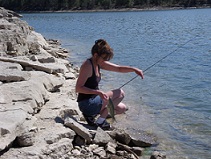Tag: pond management
WHY FEED YOUR FISH – BY BOB LUSK
Pond Boss subscriber Shane Howell of Dallas stepped on rocks near one of five shoreline feeders surrounding his spanking-new 30-acre Oklahoma lake. He pushed the timer button, then stood back to watch the action as thousands of tiny protein-laced nuggets pelted the water’s surface. 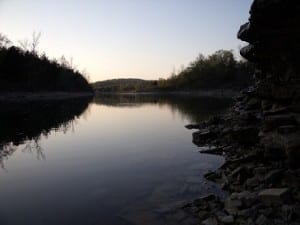
Hundreds of young bluegill and fathead minnows welcomed the offering, and quickly dispensed with the free meal, in a frenzy fit for starving piranha.
“We designed and stocked this lake to become a trophy bass lake,” Howell said with a smile, “and part of our management plan is to feed the baitfish.”
Feed the baitfish? What gives? Why put protein pellets in the water that the top-end gamefish may or may not eat?
Those are questions many fish pond owners ask themselves. Should you feed your pond fish? Nationwide, biologists disagree on the issue of feeding pond fish.
Proponents point out that high-protein pellets supplement the natural food supply in a fish pond and directly boost growth-rates among certain species, while indirectly improving the rates on some others. Rainbow trout, for instance, can be fed like so many barnyard chickens.
Then again, you might hear some negatives, such as: It’s a commitment. The cost is prohibitive. Feeding causes fish to congregate, altering their behavior. It’s like welfare. Pellets aren’t “natural” in a pond. Water quality is changed, forever.
So’s which side is right? Here’s how to decide the issue for yourself.
If you want to expedite growth-rates of bluegill, catfish and trout, or if you want to increase standing crops of fish in your pond, the answer is simple. Feed the fish.
For every two pounds of protein-rich, pellets (I recommend the floating variety) a group of fish consumes, those fish collectively gain a pound. The fish in your pond now weigh one more pound than before. Two pounds of feed, a pound of fish, and so on.
Let’s look a little deeper into the numbers. The best fish foods cost about 30 cents a pound. So, 60 cents of feed grows a pound of fish.
Stocked any fathead minnows lately? Priced at $10 a pound, fathead minnows can not compete with commercial pellets when it comes to feeding your pond fish.
Trying to grow huge largemouth bass? So many Pond Boss readers are.
Ol’ Bucketmouth won’t dare eat a prepared, pelleted diet. Heck, sitting atop the food chain, with a mouth big enough to swallow a cantaloupe, bass can eat anything in the pond, especially living critters. Bass snub tiny little pellets. Largemouth have bigger fish to fry, so to speak.
But what does a largemouth love to eat? Bluegill. And Mr. Bluegill loves to eat pelleted fish food.
Aha. Feed the fish that feed the bass. By so doing, you have created your own miniature food chain.
A well-managed pond, covering half a surface acre up to three acres, can grow and maintain 200-to-300 pounds of channel cat or trout along with 200-to-300 pounds of forage fish, per surface acre. That’s with an abundant supply of bluegill and other forage species. But, if you were to add high-protein fish food, the same pond can easily double that production.
Arguments arise. Is feeding a commitment? You tell me.
Much of the U.S. has at least 200 days of growing season, slightly less in the Upper Midwest and northern New England, fewer still in Canada. For the sake of creating a model feeding program for a mythical pond, let’s just say you intend to feed only three or four days, maybe five days some weeks. 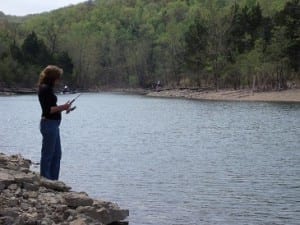
Your fish consume all of what you feed, say four pounds a day per surface acre of water. Over the course of 150 days, you feed 600 pounds of feed. Those 600 pounds of feed yield 300 pounds of fish, doubling your ponds natural production capabilities.
Do the math: Six hundred pounds of feed, at 30 cents a pound … $180. Less than $200 to put 300 pounds of weight on your fish. Cheap. I consider that a bargain.
Can you feed more? Sure, but be careful.
Two pounds of feed yields a pound of fish, but there is a balancing act to consider. For every pound you feed to the fish, there’s a pound of nutrients, some converted to energy, some processed by the fish and expelled into the water as waste. When waste dissolves in your pond, the water must process it.
Too much feed can result in too many pounds of fish, too many pounds of waste, and ultimately, problems with your water quality, if your pond water can not work with Mother Nature to clean up the extra mess. In extreme cases, I have seen overfed ponds end up with massive die-offs related to poor water quality and low levels of dissolved oxygen.
Feeding catfish? Grow Mr. Whiskers to two pounds, then catch and eat the little darling. Want bigger catfish? Stock lower numbers in the beginning. Want to name them? Stock fewer yet.
In short, do not overfeed, or plan on removing a few fish as you go along. Otherwise, your fish and your water quality will suffer.
Here’s one of my Rules of (Wet) Thumb: Never feed more than 10-to-20 pounds of floating fish food, per surface acre, per day.
Theory can get a little complicated, since young, fuel-burning fish, converting at a rate of 2-to-1, will eat 3 percent of their body weight per day during the growing season. So, keep your feeding program simple. 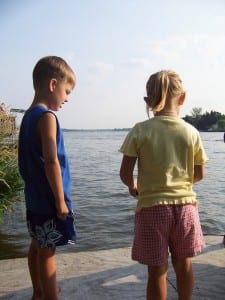
To keep it simple, I recommend that in most sportfishing ponds that you feed no more than twice a day, for brief durations, once in the morning, once in the late afternoon. Feed only what the fish will clean up 10-to20 minutes. Otherwise, you’re wasting your money to watch the wind and waves carry your pellets to the other side of the pond.
Either way, keep your feeding program simple and consistent. Feed from the same place, same time, each day. As your fish grow, you may discover that where you once were feeding for production, now you are feeding to maintain. That’s when you reach decision time.
Do you feed the same amount of feed, to the same number of fish that stay the same size? Or do you reduce numbers to increase individual size?
Some biologists contend that feeding fish is akin to welfare. It creates an artificial environment. Point well taken.
Granted, when you offer pellets to a fish, it tends to leave the real world of fish-eat-fish. But it’s a balancing act. The fish you feed are not necessarily taken out of competition, but they compete less with other fish for natural prey in your pond.
In that regard, feeding pellets makes “more” natural food, to be distributed among all fish, not just a few. This increases a pond’s ability to support fish — the very point of pond management. 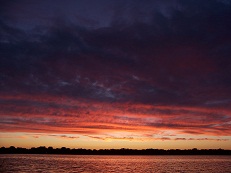
Critics say a feeding station tends to congregate fish, to pull them away from their natural underwater home. Absolutely. When the dinner bell rings, fish come from as far as 100 feet away.
Bluegill and minnows surface to attack the pellets, then disappear just as quickly as they came. Hybrid stripers can put on quite a show of force when they gulp down pellets. Bass take note, too. A big bass will not be attracted to the pellets, but to the creatures partaking of the free offerings.
After all, bass won’t turn down an easy meal either. Bluegill eat fish food; bass eat bluegill eating fish food. In nature, there’s always a payback.
Too many fish can jeopardize water quality, so feed less or reduce the number (or size) of the fish. One option is adding an aerator. The tiny air bubbles bursting at the surface help Mother Nature to combine oxygen and sunlight in helping to flush or “burn” the waste products.
Rule of (Wet) Thumb: Buy good fish food. Read the bag tag, make sure the feed contains at least 28-to-32 percent digestable protein. Read the ingredients, looking for the words “fish meal.” If you don’t see those words, don’t buy the food.
For best results, use only feed intended for fish. Feed dog food to dogs, monkey food to monkeys. Your fish deserve the real meal deal.
When it comes to feeding, pond owner Shane Howell has it figured out.
“Since our goal is to grow trophy bass, and this is the first year our lake has been stocked,” he said, “we decided to grow as much baitfish as possible, to grow the biggest bass possible.”
Howell knows that it takes at least 10 pounds of baitfish for his bass to gain a pound. In his fishing hole in south-central Oklahoma, five feeders pitching out 10 pounds of feed each day will set the buffet table for his bass to grow as fast, and as large, as they can.
Howell has done the math … 10,000 pounds of feed over 200 days will produce an extra 5,000 pounds of baitfish for the 1,500 Florida bass fingerlings he recently stocked. That’s an extra 170 pounds of baitfish per acre, (above what the lake produces without feeding) that will make his bass grow to large sizes much more quickly than a “normal” lake of similar size.
The irony of Shane’s program is that when he buys $3,000 worth of feed, the largemouth will be growing rapidly, without eating so much as one pellet.
POND BOSS Magazine is the world’s leading resource for fish, pond and fisheries management information including discussions on muddy water, raising trophy fish, fish feeding, building a pond, algae control and more. Check us out at www.pondboss.com or contact Bob Lusk, the Pond Boss himself, at 903-564-5372. His books, Basic Pond Management, Raising Trophy Bass and Perfect Pond, Want One, may be purchased by calling 800-687-6075 or ordering online at www.pondboss.com
Q&A with Ted Danson, author of ‘Oceana’
Q&A with Ted Danson, author of ‘Oceana’
Actor and activist says oceans can recover from overfishing and acidification, but only with our help.
 Photo: Kate Danson
Photo: Kate Danson MNN: What is this book about and why did you decide to write it?
MNN: What is this book about and why did you decide to write it? Why did you feel the need to become an ocean activist?
Fishing structure works….
Structure Fishing 101
written by Tim Allard
Structures are a big factor in fish habitat and certain types will concentrate fish.
Structures are areas where there is a variance in the depth or contours of the lake bottom.
If you’re new to fishing, knowing how to find structure and understanding how fish relate to it will dramatically improve your ability to find and catch fish. As a term, structure gets used a lot in fishing articles, television shows and presentations by professional anglers. In this guide I’ll define structure, discuss various types and share some tips for fishing them.
What is structure?
Structures are the physical features of a lake or a river bottom. From a fishing perspective, structures are areas where there is a variance in the depth or the contours of the bottom, and these changes can range from subtle to dramatic. Structures can be natural as well as human-made features of the underwater landscape. Structures are a big factor in fish habitat and certain types will concentrate fish.
Before I get any further, let me explain what structure is not. Sometimes cover is incorrectly used interchangeably with structure. Cover refers to objects in or on the water that provide shelter for fish, such as vegetation or a dock. Of course, finding structure and cover together can make great fishing spots (e.g., a hump with a dense weed bed), so it’s no surprise that the two terms get used interchangeably.
Some Basic Structures
Here are some common fishing-structures. A ledge is the beginning of a distinct change in depth. It marks the top of a drop, which is simply the sloping of the bottom towards deeper water. Ledges and drops are main structures that hold many freshwater species, such as walleye and muskie. Add a weedline in close proximity to a ledge or a drop and they can be prime spots.
A hump is a shallow area surrounded by deeper water and often a preferred piece of structure for bass. Humps are sometimes called underwater islands. A hole is the inverse of a hump – a deep pocket in the bottom surrounded by shallow water. Holes are favorite hiding spots of bottom-dwelling hunters, like catfish.
More Advanced Structures
The above items are some basic structures, but they also form the building blocks for more elaborate pieces of structures. What follows are some of the more common fishing structures, but this listing is by no means exhaustive.
One example is a spine. To imagine a spine, first picture an underwater hump as an elastic band. Take that band, stretch it slightly and you’ve got a spine. One of the most common places to find spines is as a continuation or off of a point from a shoreline, but others exist off the end of humps as well.
The contour of spines will vary, some even have fingers running off the sides of them, and their gradient, or slope, will also vary from steep to subtle. Like a hump, spines are surrounded by deeper water, with drops and edges on each of their sides. Long spines can be travel routes for fish as they move towards shore, transitioning from deep to shallow water.
The inverse of a spine is a cut, or trough, which can be described as elongated holes. Most common in flooded areas or reservoirs, many of these structures were streambeds in their former lives before water levels rose above their banks, submerging them. Of course, drops can sometimes contain cuts in their sides that are simply grooves that were not previously riverbeds. Again, these irregularities can attract fish and are worthy of fishing and their ledges can be particularly effective at holding fish or acting as route ways.
Still got that elastic? Holding both ends, bring them together slightly until the band bows. You’ve just created a saddle between two islands or underwater humps (your finger tips). Saddles can be great structures to fish with both deep and shallow water structures as well as being corridors for fish to follow as they move from one structure to the next. Depending on their disposition, fish may be anywhere on the saddle complex. They may be tight to the islands and feeding or positioned slightly off the saddle and inactive. In this case, it pays to know the behaviors of your target species and fish these areas accordingly, but when in doubt, pick the structure apart with different lures to work a variety of depths.
Another piece of structure is the breakline (sometimes shortened to break). A breakline is really just the edge of a drop that runs perpendicular to the shoreline. If you’ve ever trolled along the shore in an S-pattern, running between shallow and deep water, you’ve been fishing the breakline. Sometimes anglers will describe the different breaks as primary and secondary. The primary breakline is the first sharp drop in depth traveling from shore outward; the secondary following thereafter and another major drop in depth. Whether you think of breaks as walls or underwater stairs, they can be good structures to fish. Yet the entire breakline does not always hold fish. What makes them great fish-holding structures is when other elements (like a cut or a bend) or cover (such as a weed edge) are added to a stretch of the break.
Why is Structure Important?
Structure often concentrates fish. Structures provide different advantages to various species (such as corralling baitfish, providing an ambush area, or being close to deep water for comfort). For reasons like the three listed above, many species seldom stray far from structure. Learning how the fish you’re targeting relates to structure and being able to find structure on the water will increase your ability to catch fish. Structures can move you away from shorelines to intimidating expanses of water that may seem void on the surface, but what lies underneath can be fishing hotspots.
Putting Structure in Context
It’s important to keep in mind that structure is but one factor in the finding-fish equation. Finding structure can put you on fish, but it’s not an absolute that you’ll catch them. Structures are often feeding areas, but if there’s no food they’ll likely not hold fish. Weather conditions and seasonal patterns are also important to keep in mind and, again, are part of a larger equation to finding fish.
Other factors affecting if structures hold fish are temperature, oxygen supply, or water quality/light penetration. Since different species have different dispositions, some structures may appeal to certain fish and not others. For example, a 12-foot hump on a gin-clear, rock bottom lake may be a smallmouth bass hotspot, but too bright an area for walleye during the day. Yet at dusk and dawn it might concentrate light-sensitive walleye that move in to feed and ambush prey. Sometimes how well structures produce fish is all about timing and putting environmental and forage factors in your favor.
Using hydrographic maps and fish finders together can make finding structure a relative easy task.
How Fish Relate To Structure
As mentioned, food and environmental factors impact the mood of fish and thus, impact how they relate to structure. A common misnomer is that if fish are not directly on top of structure, they are not there or are not relating to it. Speaking in general terms, fish “on” structure are usually aggressive (add cover to the mix and things could change), while fish suspended “off” of structure are less aggressive or in a neutral mood, resting between feeding binges (unless baitfish are also suspended off the structure). Fish distanced from structure are still relating to it and catchable, so novice anglers should learn to fish both the actual structure as well as its surroundings. It pays to ask, “How do the fish travel to this spot? Is there an obvious route on my hydrographic map?” and “If fish are not directly on the structure, where might they be off of it?”
The Tools of the Trade & Finding Structure
As mentioned earlier, the easiest structures to find are those that extend from land, such as a point. The reason is obvious; one sees the gradual slope on land and knows this piece of structure likely continues into the water. What’s difficult is finding structure when there are not hints from land. This is where a fishing finder and hydrographic maps are critical.
Hydrographic maps illustrate the bottom contours and depths, showing where the structures are on a body of water. Of course the scale of the map will impact the detail of the features it shows. Depth finders are your underwater eyes. They provide a continual reading of the depth below your boat, and help you pinpoint depth changes and find structure. Using hydrographic maps and fish finders together can make finding structure a relative easy task, even on a new lake.
A recent addition to an angler’s arsenal are GPS units, which can hold hydrographic maps as well as store waypoints, allowing you to mark structure once you find it. Of course, carrying some buoys is also handy to help you stay on structure as you fish the entire area.
Tips for Fishing Structure
I won’t try and cover how-to fish the various types of structure in one article, but I will suggest a few tips. First off, working jigs along the bottom and around the edges of structure can catch several species of fish, anglers should not just concentrate on the bottom (whether using jigs or not). Consider trying lures to work other depths around the structures. Also, try and fish “off” of structure as mentioned earlier. By this I mean if trolling the breakline, weave out into deeper water to look for suspended fish. The same concept applies when casting areas, like humps, islands and saddles.
Here’s a tip: fish sometimes suspend off of structure around the same depth as the structure itself. So, a hump that’s 12-feet deep might have a pike several feet away from the edge of the structure, suspended at 12-feet over water with a depth of 25-feet. Another important tip, which I’ve touched on already, is learning to isolate prime structure by considering other factors influencing fish behavior (such as food, cover, environmental elements, and so on).
Once you’ve done your homework and found structure you think will hold fish – take the time and fish it thoroughly. Many anglers work large structures too quickly, and if a big trophy is relating to a certain, special area on the structure (often called “the spot on the spot”) you might pass over her.
Learning about structure is just another way of thinking to solve the “Where are the fish today?” puzzle. Use maps and read up on your favorite species and how they relate to structure and you’ll find yourself catching more fish. Large pieces of structure can be intimidating to fish, so take the time to look for the best areas (considering other fish-factors) and fish them thoroughly.
Share this article with your fellow outdoorsmen:
Increasing Fish Production
Ohio Pond Management
Increasing Fish Production
Methods of Increasing Fish Production
Fertilization
Artificial Feeding
Adding Fish Habitat Structures
Pond owners should view their ponds as selfsustaining bodies of water that are capable of providing all of the ingredients necessary for good fish production. The amount of fishes that can be harvested depends upon a pond’s ability to produce them, and this amount varies from pond to pond. Ohio ponds can often support up to 250 pounds of fish per acre, although this amount is generally less for ponds that are smaller than one acre. If a pond’s normal fish production is less than what the pond owner deems acceptable, it may be possible to enhance production.
The most effective methods to artificially increase fish production are pond fertilization and fish feeding (pellet feeding pictured). However, each of these methods can also cause pond problems, so pond owners should consider them only after carefully weighing the trade offs associated with trying to increase fish production.
Fertilization
Fertilization can improve fish production by increasing the production of tiny plants and animals at the bottom of the food chain, the phytoplankton and zooplankton. This increase in production at the bottom of the food web may ultimately translate into improved growth and production of sport fish. However, negative impacts from fertilization can also result if the added nutrients stimulate growth of undesirable types of aquatic vegetation and algae. Whereas excess vegetation can be a problem to anglers and swimmers during warm weather months, it can also make the pond more susceptible to fish kills due to a build-up of dead and decaying plant material. The pond owner may find that the cost of fertilizer, effort to maintain a fertilization program, and risk of fish kills outweigh the benefits of the increase in fish harvested.
Most ponds in Ohio are adequately supplied with nutrients from the surrounding watershed and should not require artificial fertilization. In fact, many ponds receive so many nutrients from the watershed alone that problems develop with growth of excess vegetation and reductions in water quality. The following criteria should be met if a pond is to be considered for fertilization: 1) the watershed to pond ratio is less than 20 acres of watershed per surface acre of pond, 2) the watershed consists primarily of woodland acreage with soils that are low in fertility, and 3) the pond has a minimal amount of shallow water and most of the shoreline has the recommended 3:1 slope to discourage the growth of aquatic vegetation. Ponds without these characteristics should not be fertilized.
If fertilization is appropriate, then the pond owner needs to proceed with the proper treatment applied on a careful schedule. The recommended procedure is monthly applications of liquid fertilizers 10-34-0 (N-P-K) applied at the rate of two gallons per surface acre. Treatments should begin when water temperatures reach 60°F in the spring, and stop when water temperatures drop below 60°F in the fall. Fertilization should be temporarily halted when water temperatures exceed 80°F during the summer. Dilute each gallon of fertilizer with 10 gallons of water and spray the mixture evenly over the pond surface. Water clarity is a simple and convenient way to measure the progress of a fertilization program. The water clarity should be monitored twice each month throughout the fertilization season. This is easily accomplished by simply lowering a white object into the pond, such as a coffee mug on the end of a string. The white object should be visible to at least 18 inches below the water’s surface. If the object is not visible down to 18 inches, overfertilization may be a problem. In this case, postpone the next fertilizer treatment until the water has cleared somewhat and remeasure water clarity.
Artificial Feeding
Feeding is the most direct and reliable method to increase production of bluegills and channel catfish in ponds that are less than five acres. Proper artificial feeding will increase fish growth and provide larger fish for anglers. Unlike fertilization, with artificial feeding all of the nutrients go directly into fish production rather than the complex food chain. For ponds less than five acres, feeding is a feasible way to increase fish production. Bluegills and channel catfish will readily eat pelleted feeds that are available at agricultural feed stores. Pellet feed containing at least 25 to 32 percent protein will produce the best growth. Largemouth bass prefer live natural foods and will seldom eat pelleted feed.
Training fishes to accept artificial pellets may take a few days. When bluegills are feeding on the surface in the evening, tossing a few floating pellets into the areas where they are feeding will teach them to eat pelleted food. Begin an artificial feeding program by feeding fish about two pounds of pellets per acre per day. This amount may be increased to 15 pounds per acre per day after they have become accustomed to being fed. The feeding rate should be adjusted in the summer according to how much the fish are eating. Feeding may slow or even cease during the summer if water temperatures get above 85°F.
The best guide to feeding fishes is to give them no more than they can eat in 15 to 20 minutes. Using floating pellets in a feeding ring is a good way to monitor how much food they are eating. A feeding station approximately three feet in diameter can be constructed by sealing the ends of a piece of corrugated field tile. Connect the ends after sealing to form a three-foot circle and place the tile in an area of the pond that can easily be reached to fill with food (pictured right).
A pond owner should be willing to make a long-term commitment to continue feeding before a feeding program starts. Feeding should begin in the spring when water temperatures reach 60°F and should stop in the fall when water temperatures drop to 60°F. Fish should be fed daily at approximately the same time and in the same place. Missing a few days of feeding while on vacation will not cause problems if feeding is consistent during the remainder of the summer. Overfeeding fish can cause many of the same problems as overfertilization. Food that is not eaten by fish will decompose and use up the pond’s dissolved oxygen (see fish kills). Decomposing food can also release nutrients into the water that may promote the growth of aquatic vegetation and algae.
Adding Fish Habitat Structures to the Pond
Habitat structures –“fish shelters,” or “fish attractors”– are primarily designed to concentrate fish and increase an angler’s chances of success. Depending upon the size and type of materials used, structures can provide cover, resting areas, and feeding areas. Habitat structures can act as substitutes for natural cover in ponds where these types of areas are lacking.
Habitat structures can be constructed from many different natural and man-made materials. Easily obtained materials such as discarded Christmas trees can be banded together, weighted and sunk, although trees such as oak, hickory, and cedar work best due to their resistance to decay (brush pile picture right) . Man-made materials such as PVC pipe, field tile, concrete block, and wooden pallets can also be fashioned into fish attracting devices. Habitat structures can be placed into the pond from the bank if the structures are not too large and there is relatively deep water near the shore. Larger structures can be placed from a boat to allow access to deeper water.
Winter ice cover provides an excellent opportunity to build and place structures too large to install from the shore or by boat. These structures can be built on the ice, or built on shore and dragged out onto the ice. In either case, the structure is placed on the ice and allowed to fall into the desired location when the ice melts (see brush piles on ice to the right).
Fishes & anglers alike will make the best use of habitat structures that are distributed carefully in the best locations. These structures are best placed in water that is within reasonable casting distance from shore & two to eight feet deep to allow consistent fish use. Habitat structures should not be placed in the deepest part of the pond where low dissolved oxygen levels (common during summer) make them inaccessible to fish.
developer faces fines for harming fish habitat
Mill Creek developer faces fines for harming fish habitat
Department of Ecology fined real estate developer David Milne $134,000 in connection with mismanagement of a 40-acre construction site that destroyed salmon and steelhead habitat in Mount Vernon — the third penalty for Milne in just over a year.
Seattle Times staff reporter
A Mill Creek-based real-estate developer has been fined for the third time in a little over a year by state regulators for mismanagement of construction sites that destroyed salmon habitat.
David Milne was fined $134,000 on May 1 by the state Department of Ecology in connection with more than 250 violations of stormwater regulations at a 40-acre construction site in Mount Vernon in 2008.
It was the third recent penalty in the past year for Milne, whose firm David Alan Development Co., was fined twice in 2009 for similar violations at the Horstman Heights construction project in Port Orchard. Ecology fined the company $28,000 in January 2009 and $48,000 in April 2009 in connection with that project. Milne has yet to respond to the agency, let alone pay the fines, said Katie Skipper, spokeswoman for the agency.
Ecology Director Ted Sturdevant said the agency’s next step will be to seek liens against the developer’s property. “Part of it is how do we make him pay for what he has done, and the other is how do we keep him from doing this again,” Sturdevant said.
The developer could not be reached for comment Thursday.
The most recent violation damaged a mile of steelhead and salmon spawning habitat, according to the agency, when on May 21, 2008, a stormwater detention pond failed on Milne’s Parkwood development. A flood of muddy water powerful enough to rip trees and stumps from the ground blasted down slope to Thunderbird and East Thunderbird Creeks, tributaries of the Skagit River, Skipper said.
The mud, water and debris scoured the bottom of the two creeks and settled in Trumpeter Creek. The creeks are home to coho and chinook salmon and steelhead trout. Both populations of chinook and steelhead are listed for protection under the federal Endangered Species Act. Juvenile salmon had been documented in the creek by state wildlife staff weeks before the stormwater pond blew out.
The failure was the result of a year of little or no effort to properly manage the construction site as required by federal and state law, as outlined in a construction stormwater permit granted to Milne, according to Ecology.
Inspectors repeatedly reported violations at the residential development, where Milne hired a series of contractors to prepare the 40-acre site for development — including clearing and leveling half of the site. Violations ranged from unstable soils to muddy water flowing from the site to the unfinished pond. Milne stopped paying the contractors, who left the site unsupervised, and conditions deteriorated until the pond failed, the agency says.
“It was a really egregious example,” Sturdevant said. “It’s hard for people to realize even in small amounts, when you add that up over a large amount of raw ground, it can really add up and mess with fish.”
Lynda V. Mapes: 206-464-2736 or lmapes@seattletimes.com
The Largest Fish Habitat Restoration Project in America
Shimano donated a specially designed pontoon boat adapted from the Shimano Live Release boat program to transport and strategically place thousands of fish habitat structures throughout the lake.






Bassmasters of Delaware add needed fish structure
The club participated in the DNREC’s Division of Fish and Wildlife GO FISH program which stands for Fill In Structural Habitat. The GO FISH program consists of clubs applying to the DNREC program requesting to plant artificial or natural fish attractors in area ponds and lakes to enhance the habitat for all species of fish. Members of Eastern Shore Bassmasters collected discarded Christmas trees after the holidays and constructed bundles of trees that were weighted with concrete blocks and placed in the ponds in areas that are productive places for fish to seek shelter and food.
The tree bundles also serve as fish attracting features along the shoreline to provide more opportunities for shoreline anglers, or bank fishermen. Multiple shoreline fish attractors were placed in the pond along the fishing access areas including areas along Griffith’s Lake Drive. Two (2) of tree bundles will be made visible to bank fishermen through the Division of Fish and Wildlife identifying the two locations as fish attractors on the pond’s map, and placement of signs at the park indicating such. The other thirteen (13) tree bundles were placed in areas to provide cover and safe habitat for fish throughout the pond.
The tree bundles were constructed by taking two (2) trees joined side by side and tied at the trunks and tips. The concrete blocks were then fastened one to each end of the bundle to help sink the trees and hold them in place in the water. The trees were placed by members of the club, with the assistance from the DNREC Fish and Wildlife workboat and crew on hand to assist, in various locations on the pond in no less than five (5) feet of water, as not to impede boat navigation.
The club considered the idea to enhance habitat in area ponds due to the large numbers of ponds with featureless lake cover and structure such as stumps, weed beds, submerged timber, rock piles, and dock pilings. The consideration was given to bank fishermen as well to attract more numbers of fish closer to shore. The fish attractors will provide opportunities for more anglers as more fish become accustomed to using the tree bundles for cover, food, and staging areas.
Griffith’s Lake was selected as this year’s location as somewhat of a resource management option. The lake back in 2006 suffered an unexpected partial drawdown that occurred when a leak developed under the dam and put it at risk for losing quality fish and habitat. It is the club’s goal to help restore some of the habitat and provide for a better angling experience for more fishermen, as well as provide the necessary habitat and cover with the tree bundles for promoting healthy populations of all fish species.
Club President Dave Perrego and Conservation Director Bob Wallace have been in contact with DNREC’s Cathy Martin, a fisheries biologist for the Division of Fish and Wildlife and GO FISH program administrator since early this year. This is the 2nd habitat planting project in Kent County in two years. The last took place at Killen’s Pond in Felton back in April of 2008.
For more information on how your Delaware club or organization can participate in the GO FISH program you may contact Ms. Cathy Martin at (302) 653-2887, or email her at catherine.martin@state.de.us.
To contact the club to inquire about future conservation projects and general membership, please call Dave Perrego at (302)339-2133, or email the club ateasternshorebassmasters@yahoo.com. The club’s website can also be found at www.eteamz.com/easternshorebassmasters.
Spring Bass fishing Tactics
Each and every spring, bass angling fanatics yank out their bass tackle and start for the lake. Most are starting the season a little too early, but Continue reading “Spring Bass fishing Tactics”
Spring is time for Crappie fishing and adding new fish habitat.
Well folks now that the winter is near over and the ice is off most of the lakes, ponds, rivers and streams all we need to do know is wait for the crappie spawn to catch some big slab spring crappie Wrong! Spring crappie fishing right after ice out is the most amazing time of year to catch trophy slabs. The fishing pressure will be light because of the still very cold weather. If you can tolerate some very inclement weather you will experience some of the most amazing spring crappie fishing. 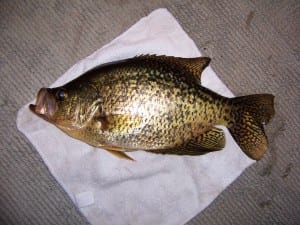
After ice out it is time to go out and start your spring crappie fishing. The crappie are still in deep water but will start their move into holding areas close to their spawning beds. They will be hungry and will their feeding in earnest The water is extremely cold, so you will have to use a very slow bait presentation. The trick is being able to locate the fish, there are some fundamentals you need to be aware of to find the big slab pre-spawn spring crappie. Oh you won?t have to be out on the lake at first light either. It has been my experience , afternoon is better this time of year because there is some sun warming and the crappie feed on the moving bait fish more in the afternoon.
Start your fishing at the last ice fishing location. If you don?t ice fish contact some ice fisherman and find out their last fishing locations. The fish will be holding at these locations right after ice out. If your lake is shallow, head to the deeper boat channels around your lake, the fish will be locate here. In deeper lakes head to narrowing creaks and channels feeding off the lake the spring crappie will be located there. I rivers head for channels that feed off the main river. 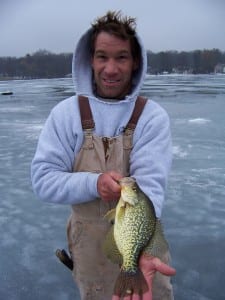
When fishing In cold water I prefer ultra light equipment. When your fishing for spring crappie the bite will most likely be very light. You need to be able to feel the bite to catch fish Use 2lb test and an open face reel and a graphite rod, with a good tip. If you are breaking line and snagging a lot move to 4lb fluorocarbon.. I recommend you use 1/32oz or 1/16oz jig heads that have eyes painted on them. The color of the jig head can very, but my preference is chartreuse or pink. with split tail plastic tubes. with some glitter color. My preference is to use clear color tubes with some glitter color in them for clear water. In murky water use white or yellow. If the water is real muddy use chartreuse.
If you use these tips you will be successful. When you catch a giant slab crappie in early spring there is no better feeling. Well good luck with your spring crappie fishing.
Don’t for get to build up the fish habitat for your crappie to enjoy. Shallow habitat for fry is the first step in growing big slab crappie. Artificial fish attractors and fish habitat grow algae fast and protect young fry for larger predators. Fishiding.com
